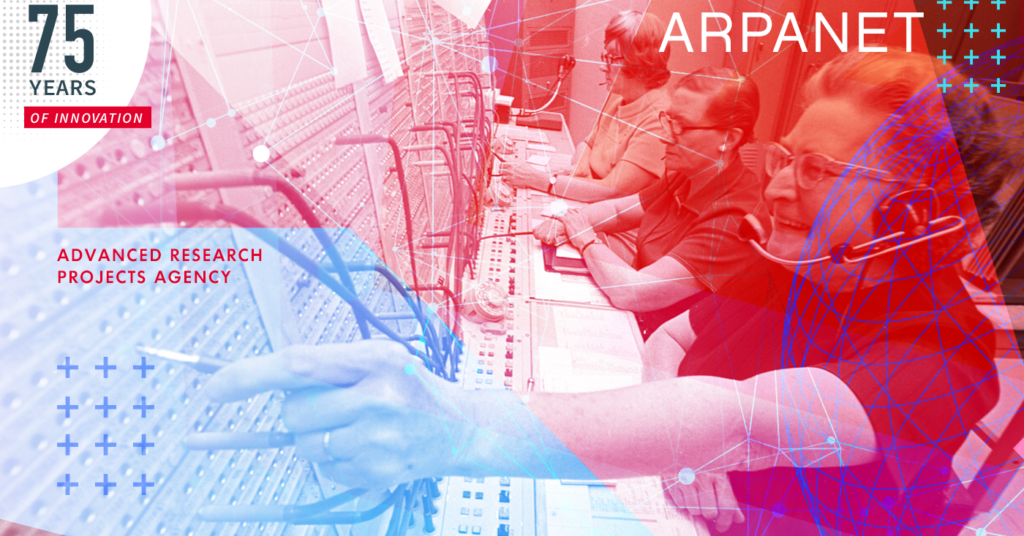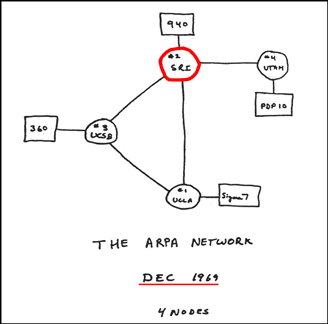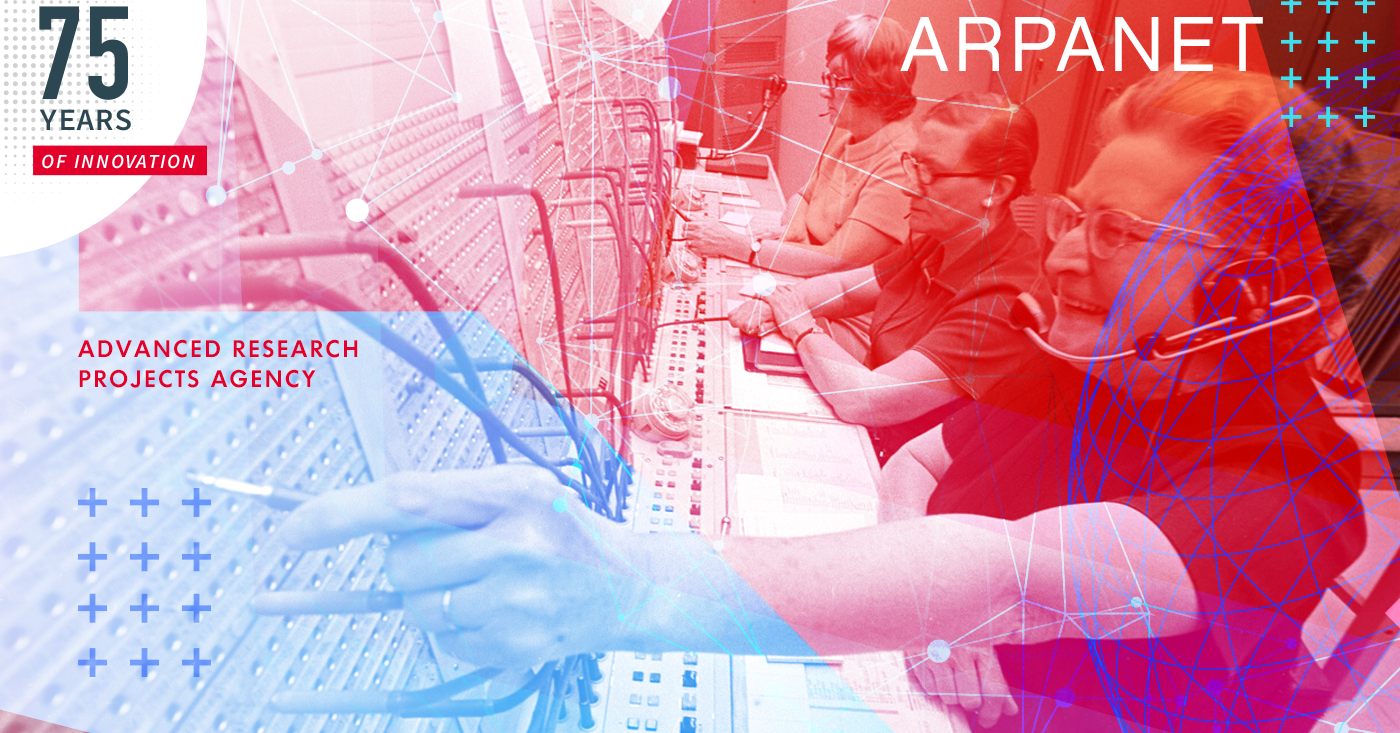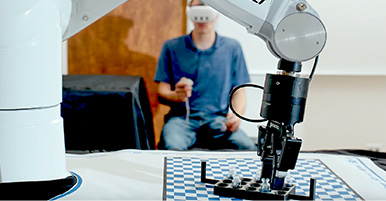A collaborative project that gave rise to the modern internet
The 75 Years of Innovation series highlights the groundbreaking innovations spanning from SRI’s founding in 1946 to today. Each week, SRI will release an innovation, leading up to its 75th anniversary in November 2021.

From ARPANET to the internet: How a small step in computing became one giant leap for connectivity
1969 was a pretty amazing year. Neil Armstrong and Buzz Aldrin became the first humans to walk on the moon; the Beatles played their last public performance on the roof of Apple records; and, the nascent internet was released to the world in the form of ARPANET.
In some ways, writing about the internet on the internet feels a little like looking into an infinity mirror; the internet is everywhere we look. The internet has heralded in so many things that are changing our world, like social media, cashless transactions, and remote working during (and after) the COVID-19 pandemic.
Subsequently, the internet is big, really big, but some of its first baby cries were heard as a much smaller project way back in the sixties. This is the story of how SRI International helped to bring the world a step closer to the internet…
The pathway to the information superhighway
The internet is so revolutionary because it allows information to be communicated across geographically separate computers. In the 21st century, this seems almost trite, a modern normal that many folks take for granted. But back in the 1960s, the concept of being able to communicate across disparate computers was nothing short of a revolution.
Back then, computers were connected using a Local Area Network (LAN). These were direct, computer-to-computer connections with one-way information flow. This severely limited computing capability.
ARPANET was conceived to build a networked system that reached out across geographies. The vision of connected computing, ARPANET, was based on a packet-switching network where data is split into “packets”. Each packet is moved to a specified location via a series of nodes using any available route. The packet switches themselves were known as an Interface Message Processors (IMP). SRI International established the first of two IMPs, UCLA hosted the other IMP.
Packet switching is the fundamental basis of the internet.
A loud L.O. to the first sighting of the internet
The internet as we know it today is a mesh of interrelated facilitative components, languages, and protocols. But certain things had to happen to bring us the hyperconnected playground we know today as the internet. The idea behind communications across connected computers was floated throughout the 1960s. ARPA, now known as DARPA (Defense Advanced Research Projects Agency), was behind the initial project, incorporating the concept of geographically distributed, networked computers. Out of DARPA funding and community input, a design for the ‘ARPANET’ was developed and a plan released to build ARPANET.
This plan was to find two IMPs or ‘nodes’ to demonstrate the capability of ARPANET to connect computers. UCLA provided the first node and SRI the second for an initial proof of concept.

Two key figures at SRI International were behind this second node and associated support. Elizabeth Feinler (an ex-chemist) was head of the Information Research Department at SRI back in the 1960s; Elizabeth pioneered the Network Information Center (NIC) for the ARPANET providing tables of hostnames and facilitating mapping and a directory of the RFCs (Request for Comments — more on RFCs later). Elizabeth was also later hired by Douglas Engelbart who headed up the Augmentation Research Center (ARC) at SRI. Engelbart provided the second node for ARPANET. Engelbart, infamous for promoting the understanding of human-computer-interaction (HCI), also worked on another of SRI’s amazing inventions, the computer mouse. ARPANET fitted perfectly with Engelbart’s work on interactive computer systems, the NLS (oNLine System).
During a historic demonstration in October 1969, the world first witnessed the flickering of connected computers that would eventually become the hyperconnected world we live in today. This first attempt was a login and the system crashed. However, the important point to note is a student at UCLA sent a message on the ARPANET to the Stanford Research Institute’s host computer. The message sent was ‘LOGIN’ but only the L and the O were transmitted before the crash.
Still, this was a first step on the road to the ‘information superhighway’ aka the internet.
And the rest was history…
A short history of ARPANET
On November 21, 1969, the ARPANET link between UCLA and SRI was firmly established. By December 5, 1969, the University of California, Santa Barbara and the University of Utah were added to create a four-node network. Each node had a different operating system to test the capabilities of ARPANET. SRI used an SDS-90 Computer; the same machine that NLS was demonstrated on.
In 1974, a commercial version of ARPANET, Telenet, was established.
In 1975 the Defense Communications Agency took over the control of ARPANET and by 1983 ARPANET became part of the Military Network (MILNET), the Defense Data Network and NSFNet, (used for scientific and academic computers).
An important step in the evolution of ARPANET on the road to the modern internet was the development in 1982 of the TCP/IP protocol. This is still the standard protocol for the internet today.
Since those early days of node-to-node communications, layers of inventions have created the internet we know and love today. This has included Tim Berners-Lee’s Hypertext Markup Language (HTML) which gave us a programming language for the web pages to build a ‘World Wide Web’ of information.
Great inventions are rarely (if ever) a sudden independent idea. When human beings make great strides in science and technology, many years, decades, even centuries of experimentation and knowledge lead up to that quantum leap. The internet is such an invention. The work on ARPANET by Douglas Engelbart, Elizabeth Feinler, and the wider team at SRI, was instrumental in the development of the modern internet we all depend upon so much today.
The process these scientists and engineers went through is recorded in a series of documents called Request for Comments (RFCs). Reading through these historical documents is poignant. From an RFC dated 30 April 1971:
“Predictions for future use of computers (and therefore computer networks) point out that “in 1975 we will process mostly data”. Therefore, the problem of sharing data on a computer network, as well as accessing data from remote nodes in some common language are extremely important.”
Resources
Douglas Engelbert in 1969 showing the: https://www.dougengelbart.org/content/view/160/93/#Watch
DARPA, Arpanet: https://www.darpa.mil/about-us/timeline/arpanet
Internet Hall of Fame, Elizabeth Feinler: https://www.internethalloffame.org/official-biography-elizabeth-feinler
The Dish, 75 Years of Innovation: The computer mouse: https://medium.com/dish/75-years-of-innovation-the-computer-mouse-fef5161ba45d
NLS: https://www.dougengelbart.org/content/view/155/87/
Internet RFC/STD/FYI/BCP Archives: http://www.faqs.org/rfcs/



